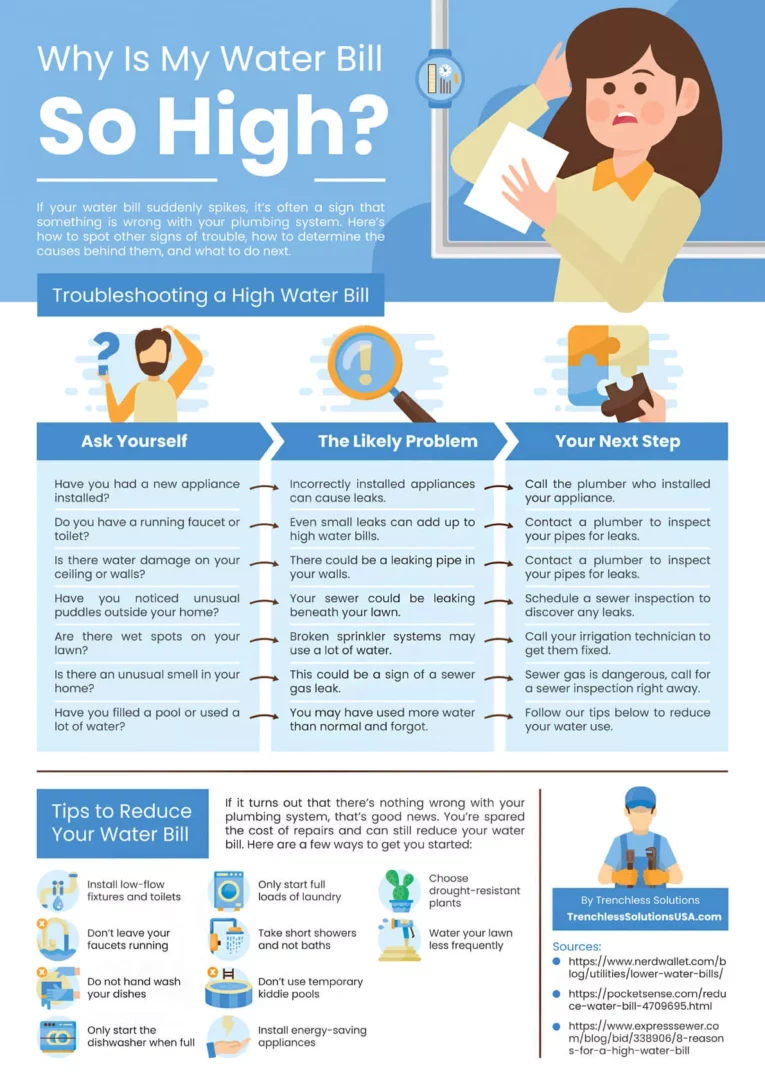Opening a water bill to find a shockingly high amount due is alarming for anyone. Most homes tend to use the same amount of water each month, so a sudden spike in usage can indicate a costly plumbing problem or other issue.
Before you panic, consider all the different possibilities as to why your water bill might be higher than usual. Below, we’ll go over the common reasons your water bill may have spiked and how to figure out which issue you’re dealing with.
Common Causes of High Water Bills
These are a few common reasons you might see a higher water bill.
Rate Hikes and Company Errors
Normally, water usage and costs will be higher in months when you water your lawn or use your pools. However, high costs can sometimes be based less on usage and more on rate hikes or billing errors. Utilities aren’t always the best communicators, and, as the saying goes, nobody’s perfect.
Compare the listed usage on your water bill to what it has been running in the last year. If it’s the same as it’s always been, contact your utility and ask if it’s recently increased rates. A representative can readjust what you owe to the correct amount if an administrative error or broken meter caused a high bill.
Water Leaks
Leaks are the most common cause of high water bills. Check all of your home’s fixtures and appliances for visual or audible leaks, and look for wet spots that indicate internal water leaks.
If you have an outside sprinkler, check areas where you have junction boxes and exposed pipes. Pipe bursts can cause substantial damage to your home and are far more concerning than minor leaks, but you must plug any leak you can find.
If you see signs of a leak, shut off the main water valve immediately and contact your plumber for repairs.

Over-Running Toilets
Toilet leaks are wasteful but easy to identify. Flush the toilet and make sure it shuts off after water refills the bowl and tank. If it continues to run or starts running when you haven’t flushed at all, the valve seal may be ajar, warped, or damaged. Open the tank lid, check the mechanism, and replace defective parts as necessary.
Another method to detect toilet leaks is to add dye tablets to the tank water and wait about half an hour without flushing. If color appears in the toilet bowl, that’s a sign you have a leaky toilet valve.
Long Showers
A standard eight-minute shower uses about 15–20 gallons of water. Bring it up to 13 minutes, and usage goes up by about 10 more gallons. To save water and money, try cutting your showers to five to seven minutes, and remind others in your household to do the same.
You can also try installing a low-flow showerhead that reduces water volume. They’re available in different pressures and nozzle types.
Leaky Pools and Irrigation Systems
If you have a pool, leaks can be a substantial waste of water. Run your pool pump to check for liner and filter issues, and contact a repair professional if you find any.
Similarly, if you have a sprinkler system, a wet spot on your lawn can indicate a leak. Run the system and check the sprinkler heads and valves for breaks.
Improperly Installed Appliances
A poorly connected dishwasher, refrigerator, or washing machine hose can lead to increased water usage and damaging leaks. If you notice a usage spike after upgrading your appliances, check for leaks to the best of your ability. Contact the installing company if you see a leak or if professional inspection is the only option.
How to Trace the Cause of a High Water Bill
You can find most causes of a high water bill yourself by following these steps:
- Rule out any changes in your consumption, and ask others in your household if they’ve used more water than normal lately.
- Check your fixtures and appliances for signs of leaks. The “drip-drip-drip” sound can be quiet, so turn off your TVs and radios during your inspections.
- Start recording when you use water, and record meter readings at the same time each day to find trends in your water usage.
- If all these steps fail to give you any leads, contact a plumber to check for hidden problems.











